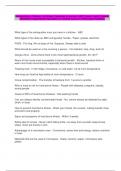Introduction to Culinary Arts Exam | Questions & Answers (100 %Score) Latest Updated
2024/2025 Comprehensive Questions A+ Graded Answers | With Expert Solutions
What type of fire extinguisher must you have in a kitchen - ABC
What types of fire does an ABC extinguisher handle - Paper, grease, electrical
PASS - Pull ring, Aim at base of fire, Squeeze, Sweep side to side
What should be used on a fire involving a person - Fire blanket; stop, drop, and roll
Danger Zone - Zone where there is the most rapid bacterial growth, 40-140 F
Room of the house most susceptible to bacterial growth - Kitchen, bacteria thrive in
warm and moist environments, especially when there is food around
Thawing food - In the fridge, microwave, or cold water; not at room temperature
How long can food be kept safely at room temperature - 2 hours
Cross contamination - The transfer of bacteria from 1 source to another
Who is most at risk for food borne illness - People with diabetes, pregnant, obesity,
young people
Cause of 95% of food borne illnesses - Not washing hands
Can you always identify contaminated foods - No, cannot always be detected by sight,
smell, or taste
How to prevent food borne illness - Wash your hands, the counter, cutting boards; thaw
and store food properly
Signs and symptoms of food borne illness - Within 3 weeks
Safety tips for knives - Never catch falling knife, cut away from yourself, keep knives
sharp, never put knives in sink
Advantages of a microwave oven - Convenient, saves time and energy, retains nutrients
in food
Materials that can be used in microwave - Glass, ceramic, paper, microwave safe
plastic
, Materials that cannot be used in microwave - Pottery or stoneware with a glaze or gold,
metal or rubber, not microwave-safe plastic, glass or ceramic with metal trim
What speeds up cooking in a microwave - Cover food, stir food, rotate dish
Special food precautions when using a microwave - Use special care when heating
liquids, stir liquids after heating, cover butter or margarine with a paper towel, vent
covered foods
Standing time - The time food continues to cook when it is taken out of the microwave
t. and tsp. - Teaspoon
T. and Tbsp. - Tablespoon
lb. - Pound
oz. - Ounce
1 quart to ounces - 32
1 pound to ounces - 16
1 stick butter to cups - 1/2
1 cup to ounces - 8
1 stick butter to tablespoons - 8
1/4 cup to tablespoons - 4
1 gallon to quarts and pints - 4, 8
1 tablespoon to teaspoons - 3
When do you use measuring spoons instead of cups - When you need to measure
small amounts
Guidelines for using measuring spoons and cups - Use liquid measuring cups for liquids
and dry measuring cups or spoons for dry ingredients, know when to pack
Function of flour - Structure
Function of fat - Tenderness and flavor
Function of sugar - Sweetness, golden brown color, tenderness




